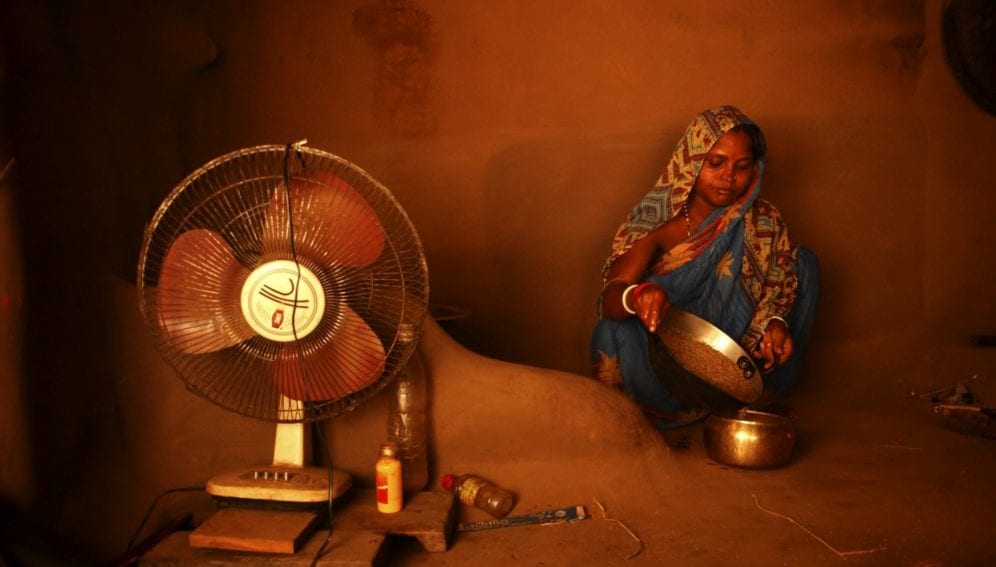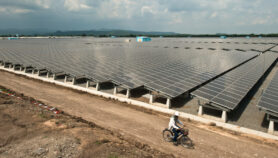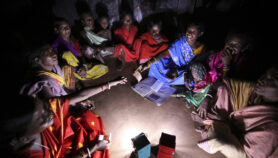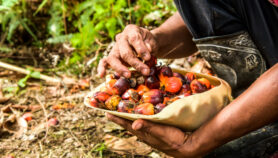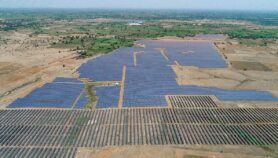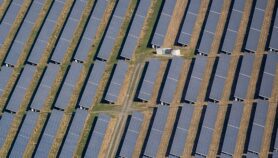Send to a friend
The details you provide on this page will not be used to send unsolicited email, and will not be sold to a 3rd party. See privacy policy.
When pursuing recently adopted global goals, South Asian governments must prioritise ending energy poverty, says Nalaka Gunawardene.
That describes the lack of access to modern energy services: household access to electricity, and clean cooking facilities. Not having these seriously limits people’s lives and livelihoods.
Using electrical or electronic items — like radios and mobile phones — requires extra battery supplies and regular charging outside. Refrigeration for food preservation is not available. Children cannot study at night except with kerosene lamps that carry fire hazards.
This is a daily reality for over two billion people worldwide who either lack electricity outright, or have a poor quality and irregular service. Most of them live in South Asia or sub-Saharan Africa.
When the energy poor turn to solid fuel alternatives — such as firewood, animal dung or coal — they are exposed to high levels of indoor air pollution. The inefficient burning of such fuels on open fires or traditional stoves inside houses exposes women to the equivalent of smoking two packs of cigarettes each day, the World Health Organisation (WHO) has warned. [1]
Several South Asian countries have chronic power shortages that limit electricity supply to a few hours each day. That uncertainty drives many connected to the national grid to have stand-by alternatives, usually costly and polluting.
Modern energy for all
One of the 17 Sustainable Development Goals (SDGs) adopted by heads of state at the United Nations headquarters in September is dedicated to energy. It calls for “affordable, reliable, sustainable and modern energy for all”, and sets the target of universal access by 2030. [2]
That is a worthy goal, but chasing it requires outpacing population growth while substantially increasing electricity generation capacity. The challenge is to do so with minimum new carbon emissions.
Some groundwork has already been done. In 2011, the UN Secretary-General launched the Sustainable Energy for All (SE4ALL) that brings together governments, business and civil society. Its aims are to provide universal access to modern energy services; double the global rate of improvement in energy efficiency; and double the share of renewable energy in the global energy mix. [3]
SE4ALL’s latest report, titled Global Tracking Framework 2015, draws on national data records for 180 countries. It estimates that between 2010 and 2012, an additional 222 million people gained first-time access to electricity. This number, more than the population of Brazil, is well ahead of the 138 million of population increase during the same period.
“Global progress was driven by significant advances in India where 55 million people gained [electricity] access over 2010-12,” the report says. But that still leaves out around 263 million Indians who are not reached by the national grid and have no alternative access to electricity either. [4]
In recent years, more development donors and charities have started tackling energy poverty, and many are doing good work. But Morgan Bazilian, lead energy specialist at the World Bank, worries about too much attention given to small-scale fixes and incremental improvements. Such approaches can set ambitions too low, “implicitly condemning billions of people to meagre levels of energy use that will do little to lift them out of poverty”.
Writing in the influential Foreign Policy journal earlier this year, he surveyed the policy, technology and investment choices of fighting energy poverty. He advocated a mix of macro- and micro-level responses to delivering affordable and sustainable energy to more people. [5]
Bazilian cites the example of Bangladesh which has recorded the fastest expansion of small-scale, off-grid solar power systems anywhere in the world. So far, more than 3.5 million solar home systems have been installed in rural Bangladesh, creating 70,000 direct jobs. The government has created a dedicated agency that provides non-governmental organisations and microfinance lenders with technical support and grants. [6]
Providing modern energy to everyone on the planet can cost from US$ 40 billion to 100 billion per year, according to different estimates. These are big numbers, but as Bazilian points out, they represent a fraction of the total amount of capital being invested in the energy sector.
Energy cooperation
How can South Asian countries give reliable electricity for all their people without further aggravating global warming?
As the world’s third largest emitter of greenhouse gases, India has just taken the lead. Early October, it announced a climate action plan to produce 40 per cent of its energy from renewable and low-carbon sources by 2030. The aim is to reduce the intensity of its carbon dioxide emissions by roughly one-third. [7]
Implementing the plan will cost at least US$ 2.5 trillion (at 2014-15 prices), between now and 2030. Some of that money is to come as international aid. [8]
Both in combating energy poverty and mitigating climate change, the eight countries of the South Asian Association for Regional Cooperation (SAARC) should explore how they can collaborate.
In fact, energy sector cooperation was a key topic at the first South Asia Economic Conclave held in New Delhi from 28 to 30 September. Speaking at the event, Nirmala Sitharaman, Indian minister of state for commerce and industry, said SAARC countries have the potential to generate an additional 300,000 megawatts of hydropower.
The breakdown she provided was: India 140,000 megawatts; Bhutan 30,000 megawatts; Nepal 42,000 megawatts; Pakistan 45,000 megawatts; and Afghanistan 25,000 megawatts. More than 80 per cent of this potential is yet to be tapped. [9]
Piyush Goyal, India's minister of state for power, coal, new and renewable energy, reported progress in India's bilateral energy cooperation with Bangladesh, Bhutan and Nepal — and ongoing efforts to build a similar engagement with Sri Lanka.
Beyond these, there is scope for multilateral collaboration among SAARC countries to tap their hydro potential to generate cheaper power with less environmental impacts.
According a recent World Bank study, South Asia is lagging behind others in regional electricity cooperation and trading. The study used an electricity planning model to quantify the benefits of unrestricted cross-border electricity trade in South Asia from 2015 to 2040. It found a potential to save US$ 226 billion (US$ 9 billion per year) of electricity supply costs over the period.
But is there enough political will and mutual trust among South Asian governments to pursue this huge potential? That remains to be seen.
The climate crisis and imperative of reducing energy poverty provide a strong case for collective action.
Nalaka Gunawardene is a Colombo-based science writer, blogger and development communication consultant.
This article has been produced by SciDev.Net's South Asia desk.
References
[2] Sustainable Development Goals. Official website.
[3] Website of the Sustainable Energy for All (SE4ALL) initiative.
[4] Progress towards Sustainable Energy: Global Tracking Framework 2015: Key Findings. International Energy Agency. 18 May 2015.
[5] Power to the Poor: Provide Energy to Fight Poverty. By Morgan D. Bazilian. Foreign Affairs. March/April 2015 issue.
[6] Lighting rural Bangladesh with roof-top solar and carbon credits. Development in a Changing Climate Blog. The World Bank. 24 March 2015.
[7] India unveils climate-change pledge ahead of global talks. Nature. 2 October 2015.
[8] India’s Intended Nationally Determined Contribution: Working Towards Climate Justice. October 2015. UNFCCC website.
[9] SAARC nations can generate 300,000 MW of hydropower. The Daily Star, Dhaka. 7 October 2015.
[10] How much could South Asia benefit from regional electricity cooperation and trade? World Bank. 26 June 2015.


